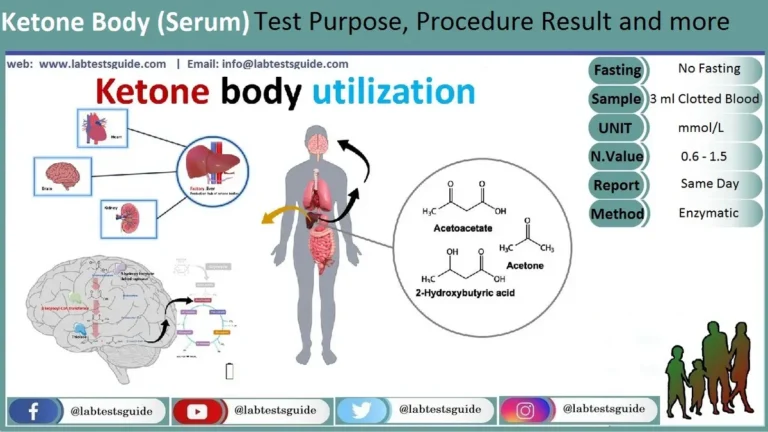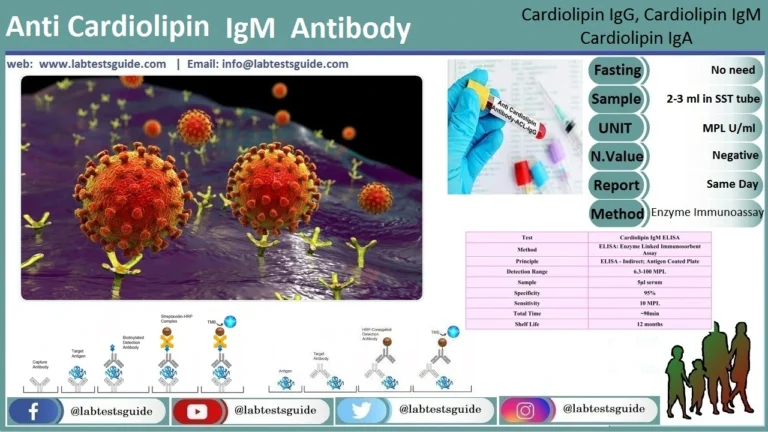Parathyroid hormone (PTH Test) is a hormone released by the parathyroid glands to control calcium levels in the blood. It also controls phosphorus and vitamin D levels. If your body has too much or too little parathyroid hormone, it can cause symptoms related to abnormal calcium levels in the blood.
| Also Known as | Parathormone, Parathyrin, PTH, Parathyroid Hormone |
| Test Purpose | To measures and monitors the level of Parathyroid hormone in your blood. |
| Test Preparations | no special preparations are required for a PTH test. |
| Test Components | PTH, IPTH |
| Specimen | 3 mL (1.5 mL min.) Serum from 1 SST drawn between 8-10 am in a fasting condition. |
| Stability Room | 2 Hrs |
| Stability Refrigerated | Hrs |
| Stability Frozen | 4 Weeks |
| Method | ELISA, CLIA |
| Download Report | PTH Sample Report |

What is Parathyroid Hormone ?
Parathyroid hormone (PTH) is a hormone produced by the parathyroid glands, four small glands located in the neck near the thyroid gland. PTH regulates the level of calcium in the blood by increasing the absorption of calcium from the gut, stimulating the release of calcium from bones, and decreasing the excretion of calcium in urine. High levels of PTH can indicate hyperparathyroidism and low levels can indicate hypoparathyroidism. Both conditions can cause problems with bone health and can have a variety of symptoms. PTH levels are often measured in blood tests to help diagnose and monitor these conditions.
Why to get PTH Test ?
There are several reasons why a healthcare provider may order a PTH test. Some common reasons include:
- To evaluate bone health: PTH levels can provide information about the health of the bones. High levels of PTH can indicate that the bones are being broken down too quickly, while low levels can indicate that the bones are not being rebuilt properly.
- To diagnose or monitor hyperparathyroidism: High PTH levels can indicate that one or more of the parathyroid glands are overactive, which is a condition called hyperparathyroidism. PTH tests can help to diagnose this condition and monitor its progression.
- To diagnose or monitor hypoparathyroidism: Low PTH levels can indicate that the parathyroid glands are underactive, which is a condition called hypoparathyroidism. PTH tests can help to diagnose this condition and monitor its progression.
- To monitor treatment for bone disorders: If a person is being treated for a bone disorder, such as osteoporosis, PTH levels can be used to monitor the effectiveness of the treatment.
- To check for kidney stones: High levels of PTH can indicate that the person is at risk of developing kidney stones, PTH tests can help to identify this condition.
It’s important to note that PTH test should be ordered by a healthcare provider as part of a comprehensive evaluation and in conjunction with other tests.
When to get Tested ?
No special preparations are required for a PTH test.
There are several situations in which a healthcare provider may order a PTH test. Some common scenarios include:
- When a person has symptoms of a bone disorder, such as osteoporosis, a PTH test may be ordered to evaluate the health of the bones and to help diagnose or monitor the condition.
- When a person has symptoms of hyperparathyroidism, such as weakness, fatigue, and bone pain, a PTH test may be ordered to help diagnose or monitor the condition.
- When a person has symptoms of hypoparathyroidism, such as tingling or numbness in the fingers and toes, muscle cramps, and seizures, a PTH test may be ordered to help diagnose or monitor the condition.
- When a person is being treated for a bone disorder, such as osteoporosis, PTH levels may be monitored to evaluate the effectiveness of the treatment.
- When a person has a history of kidney stones or a family history of kidney stones, a PTH test may be ordered to check for high levels of PTH, which can indicate that the person is at risk of developing kidney stones.
- PTH test is also done as part of routine check-up to check if there is any parathyroid dysfunction as part of the metabolic profile.
It’s important to note that PTH test should be ordered by a healthcare provider as part of a comprehensive evaluation and in conjunction with other tests.
How to Prepare for the PTH Test
The preparation for a PTH test typically involves the following steps:
- Inform your healthcare provider of any medications you are taking, as some medications can affect PTH levels.
- Avoid taking calcium supplements or antacids for 24 hours before the test, as they can affect PTH levels.
- You may be asked to fast for several hours before the test, so you should avoid eating or drinking anything except water during this time.
- You should wear comfortable and loose clothing as you may need to remove clothing from the waist up for the test.
- Let your healthcare provider know if you have a history of bleeding disorders or if you are pregnant, as these conditions may affect the test results.
- It is also important to let your healthcare provider know if you have had any recent surgeries, radiation therapy, or trauma to your neck as it can affect the results of the test.
It’s important to follow your healthcare provider’s instructions carefully and to arrive on time for your appointment. If you have any questions or concerns about the test, be sure to speak with your healthcare provider before the test.
Sample Required for Test:
3 mL (1.5 mL min.) Serum from 1 SST drawn between 8-10 am in a fasting condition.
- The serum of the patient is required.
- A fasting sample is preferred.
- Place on ice.
- The serum should be separated immediately because the PTH is unstable at room temperature and even on refrigeration.
- Refrigerate during centrifugation.
- Immediately freeze the sample.
- Can store at -20 °C to -70 ° C.
- A lower level has seen if the sample left at room temperature even for 4 hours.
- Also, a lower level has seen if the sample is kept at 4 °C for one day.
- If the chemical method allows then the EDTA plasma is the best choice.
- Simultaneous estimation of total calcium, ionized calcium, and phosphorus is recommended
Normal values:
Source 1
- Intact PTH molecule = 10 to 65 pg/mL (10 to 65 ng/mL)
- N-terminal intact PTH = 8 to 24 pg/L (8 to 24 ng/L)
- C-terminal intact PTH = 50 to 330 pg/L (50 to 330 ng/L)
Source 2:
C- terminal and midmolecule
- Serm (by RIA)
- 1 to 16 years = 51 to 217 pg/mL
- Adult = 50 to 300 pg/mL
N- Terminal
- Serum (by RIA)
- 2 to 13 year = 14 to 21 pg/mL
- Adult = 8 to 24 pg/mL
Intact molecule
- Serum (by ICMA))
- Cord blood = ≤ 3 pg/mL
- 2 to 20 year = 9 to 52 pg/mL
- Adult = 10 to 65 pg/mL
Increased PTH Level Is Seen In:
Increased PTH levels, also known as hyperparathyroidism, can be caused by a variety of factors. Some common causes of elevated PTH levels include:
- Hyperplasia of the parathyroid glands: This is when one or more of the parathyroid glands become enlarged and produce too much PTH.
- Parathyroid adenoma: This is a benign tumor of the parathyroid gland that can cause it to produce too much PTH.
- Parathyroid carcinoma: This is a rare cancer of the parathyroid gland that can cause it to produce too much PTH.
- Chronic kidney disease: When the kidneys are not functioning properly, they can’t remove enough PTH from the blood, leading to high levels of PTH.
- Vitamin D deficiency: Vitamin D helps to regulate PTH levels, so a deficiency can cause PTH levels to rise.
- Familial hypocalciuric hypercalcemia: It is a rare genetic disorder that leads to high levels of calcium in the blood.
- After surgery for thyroid or parathyroid disorder: PTH levels may temporarily increase after surgery for a thyroid or parathyroid disorder.
It is important to note that not all the causes mentioned above may lead to symptoms, and some cases of hyperparathyroidism may be asymptomatic. A healthcare professional can help identify the causes after a detailed examination, evaluation and test results.
Decreased PTH Level Is Seen In:
Decreased PTH levels, also known as hypoparathyroidism, can be caused by a variety of factors. Some common causes of decreased PTH levels include:
- Damage or removal of the parathyroid glands: This can occur during surgery, radiation therapy, or trauma to the neck.
- Autoimmune disorders: Some autoimmune disorders, such as Hashimoto’s thyroiditis, can damage the parathyroid glands and cause them to produce less PTH.
- Congenital disorders: Some people are born with underdeveloped or missing parathyroid glands, which can cause them to produce less PTH.
- Magnesium deficiency: Magnesium is necessary for PTH to function properly, so a deficiency can cause PTH levels to decrease.
- Genetic disorders: Some genetic disorders, such as DiGeorge syndrome, can cause decreased PTH levels.
- Idiopathic hypoparathyroidism: This is a condition where the cause is unknown.
It is important to note that decreased PTH levels can cause a wide range of symptoms, including tingling or numbness in the fingers and toes, muscle cramps, and seizures. A healthcare professional can help identify the causes after a detailed examination, evaluation and test results.
FAQs
How accurate are PTH tests?
PTH tests are generally considered to be accurate, but the results can be affected by a variety of factors. It’s important to follow your healthcare provider’s instructions carefully when preparing for the test, and to inform your healthcare provider of any medications you are taking, as some medications can affect PTH levels.
How long does it take to get the results of a PTH test?
The time it takes to get the results of a PTH test can vary depending on the laboratory that is performing the test. Typically, results are available within a few days. Your healthcare provider will provide more information on when you can expect to receive your results.
What do high PTH levels mean?
High PTH levels, also known as hyperparathyroidism, can be caused by a variety of factors, including hyperplasia of the parathyroid glands, parathyroid adenoma, and chronic kidney disease. High PTH levels can indicate that the bones are being broken down too quickly and can lead to problems with bone health.
What do low PTH levels mean?
Low PTH levels, also known as hypoparathyroidism, can be caused by a variety of factors, including damage or removal of the parathyroid glands, autoimmune disorders, and congenital disorders. Low PTH levels can indicate that the bones are not being rebuilt properly and can lead to problems with bone health.
Can PTH levels change over time?
Yes, PTH levels can change over time. Factors such as age, diet, and medical conditions can all affect PTH levels. It’s important to have regular check-ups and follow-up tests to monitor PTH levels over time.
What are the normal range of PTH levels?
The normal range of PTH level varies depending on the laboratory, but it is usually between 10-60 pg/mL. However, the normal range may be different for certain age groups or for people who have certain medical conditions. It’s important to discuss the results of your PTH test with your healthcare provider to understand what the results mean for you specifically.
Possible References Used






